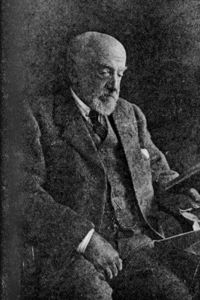
Dukinfield Henry Scott
Encyclopedia

Royal Society
The Royal Society of London for Improving Natural Knowledge, known simply as the Royal Society, is a learned society for science, and is possibly the oldest such society in existence. Founded in November 1660, it was granted a Royal Charter by King Charles II as the "Royal Society of London"...
(November 28, 1854 – January 29, 1934) was a British
United Kingdom
The United Kingdom of Great Britain and Northern IrelandIn the United Kingdom and Dependencies, other languages have been officially recognised as legitimate autochthonous languages under the European Charter for Regional or Minority Languages...
botanist.
The architect Sir George Gilbert Scott
George Gilbert Scott
Sir George Gilbert Scott was an English architect of the Victorian Age, chiefly associated with the design, building and renovation of churches, cathedrals and workhouses...
was his father. Born in London
London
London is the capital city of :England and the :United Kingdom, the largest metropolitan area in the United Kingdom, and the largest urban zone in the European Union by most measures. Located on the River Thames, London has been a major settlement for two millennia, its history going back to its...
, he was educated at Oxford University (awarded MA) and Wurzburg University (awarded PhD), studying under the famous botanist Julius von Sachs
Julius von Sachs
Julius von Sachs was a German botanist from Breslau, Prussian Silesia.At an early age he showed a taste for natural history, becoming acquainted with the Breslau physiologist Jan Evangelista Purkyně. In 1851 he began studying at Charles University in Prague...
.
From 1882 to 1885 he was Assistant to the Professor of Botany at University College, London, and from 1885 to 1892 Assistant Professor in Biology (Botany) at the Royal College of Science
Royal College of Science
The Royal College of Science was a higher education institution located in South Kensington; it was a constituent college of Imperial College London from 1907 until it was wholly absorbed by Imperial in 2002. Alumni include H. G. Wells and Brian May and are distinguishable by the letters ARCS ...
, South Kensington. In 1892, Scott left the Royal College of Science when he was appointed Honorary Keeper of the Jodrell Laboratory, Royal Gardens at Kew, a position he held for fourteen years. He published many papers on botany in scientific journals. He did important work in paleobotany
Paleobotany
Paleobotany, also spelled as palaeobotany , is the branch of paleontology or paleobiology dealing with the recovery and identification of plant remains from geological contexts, and their use for the biological reconstruction of past environments , and both the evolutionary history of plants, with a...
as the younger colleague of William Crawford Williamson
William Crawford Williamson
William Crawford Williamson was an English naturalist and palaeobotanist.-Life:Williamson was born at Scarborough, North Yorkshire. His father, John Williamson, after beginning life as a gardener, became a well-known local naturalist, who, in conjunction with William Bean, first explored the rich...
, one of the founders of paleobotany.
He was president of the Linnean Society from 1908 to 1912. He was elected a member of the Royal Swedish Academy of Sciences
Royal Swedish Academy of Sciences
The Royal Swedish Academy of Sciences or Kungliga Vetenskapsakademien is one of the Royal Academies of Sweden. The Academy is an independent, non-governmental scientific organization which acts to promote the sciences, primarily the natural sciences and mathematics.The Academy was founded on 2...
in 1916 and a Fellow of the Royal Society in June 1894.
He was awarded the Royal Medal
Royal Medal
The Royal Medal, also known as The Queen's Medal, is a silver-gilt medal awarded each year by the Royal Society, two for "the most important contributions to the advancement of natural knowledge" and one for "distinguished contributions in the applied sciences" made within the Commonwealth of...
of the Royal Society in 1906, the Linnean Medal
Linnean Medal
The Linnean Medal of the Linnean Society of London was established in 1888, and is awarded annually to alternately a botanist or a zoologist or to one of each in the same year...
of the Linnean Society in 1921, the Darwin Medal
Darwin Medal
The Darwin Medal is awarded by the Royal Society every alternate year for "work of acknowledged distinction in the broad area of biology in which Charles Darwin worked, notably in evolution, population biology, organismal biology and biological diversity". First awarded in 1890, it was created in...
of the Royal Society in 1926 and the Wollaston Medal
Wollaston Medal
The Wollaston Medal is a scientific award for geology, the highest award granted by the Geological Society of London.The medal is named after William Hyde Wollaston, and was first awarded in 1831...
of the Geological Society of London
Geological Society of London
The Geological Society of London is a learned society based in the United Kingdom with the aim of "investigating the mineral structure of the Earth"...
in 1928.
He died in East Oakley House near Basingstoke
Basingstoke
Basingstoke is a town in northeast Hampshire, in south central England. It lies across a valley at the source of the River Loddon. It is southwest of London, northeast of Southampton, southwest of Reading and northeast of the county town, Winchester. In 2008 it had an estimated population of...
, Hants. He had married Henderina Victoria Klaassen in 1887; they had six children. One of his most brilliant students was Harold Wager
Harold Wager
Harold William Taylor Wager FRS was a British botanist and mycologist. He was the uncle of the geologist Lawrence Rickard Wager. He was made a Fellow of the Royal Society in 1904...
, who became his student in botany in 1886 and went on to become F.R.S in 1904.

